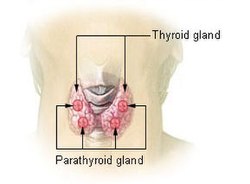Parathyroid glands
The parathyroid glands (lat. glandulae parathyreoideae) are four small, lens-like formations on the back of the thyroid glands, enclosed in its capsule. They develop from the entoderm of the 3rd and 4th gill slits. Each corpuscle is enveloped by a capsule of collagenous tissue, from which thin septa depart, which increase in size with increasing age by the accumulation of adipocytes. The parenchyma is arranged in a trabecular epithelium, in which we find chief cells and oxyphilic cells.
Microscopic Structure[edit | edit source]
Chief cells[edit | edit source]
They represent the predominant element in the gland. These are polyhedral cells with spherical nuclei and light-staining cytoplasm with a diameter of 10 μm. They contain secretory granules exhibiting argyrophilic properties (they are impregnable with salts of heavy metals – Ag, Au). These cells produce parathormone, which increases the level of calcium ions in the blood by increasing bone resorption and reabsorption in the kidney, and secondarily by stimulating hydroxylation of 25-hydrocholecalciferol in the kidney at position 1. This creates 1,25-dihydrocholecalciferol (calcitriol) increasing the absorption of calcium in the intestine.
Oxyphilic cells[edit | edit source]
Polyhedral cells larger in size than the chief cells, their nuclei are relatively brightly colored. In the cytoplasm we find a large number of mitochondria (they condition its strong eosinophilia), glycogen granules, but no secretory granules. The cells appear postnatally, around the age of 10.
Links[edit | edit source]
Related Links[edit | edit source]
References[edit | edit source]
- KONRÁDOVÁ, Václava – UHLÍK, Jiří – VAJNER, Luděk. Funkční histologie. 1. edition. Jinočany : H & H, 2000. ISBN 80-86022-80-3.
- MESCHER, Anthony L – JUNQUEIRA, Luiz Carlos Uchôa. Junqueira's Basic Histology. 12. edition. United States : McGraw-Hill Education - Europe, 2009. 480 pp. ISBN 9780071630207.



